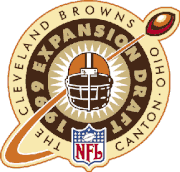| 1999 NFL expansion draft | |
|---|---|
 | |
| General information | |
| Sport | American football |
| Date(s) | February 9, 1999 |
| Location | Pro Football Hall of Fame Canton, Ohio |
| Overview | |
| League | NFL |
| Expansion teams | Cleveland Browns (reactivated team) |
| Expansion season | 1999 |
The Cleveland Browns had spent three years with its operations suspended after Art Modell had relocated the Browns' organization and players to Baltimore, Maryland to form the Baltimore Ravens at the end of the 1995 NFL season. Upon returning to the league, in order to become competitive with existing teams, the Browns were awarded the first pick in the 1999 NFL draft, and the league gave the Browns the opportunity to select current players from the other teams. That selection was provided by the 1999 National Football League expansion draft, held on February 9, 1999. 150 players were left unprotected by their teams for the Browns to draft. [1] [2]